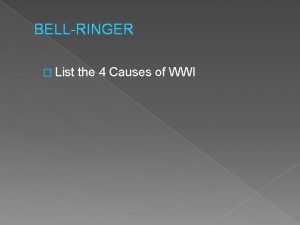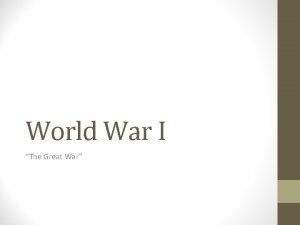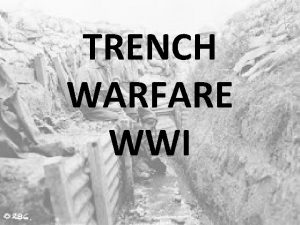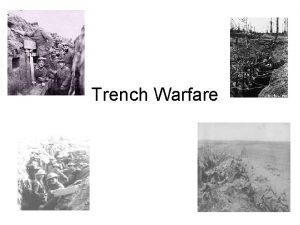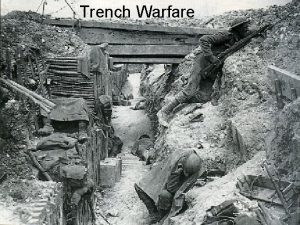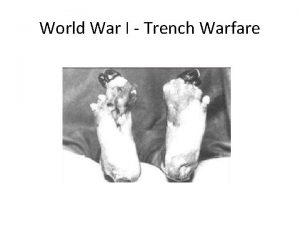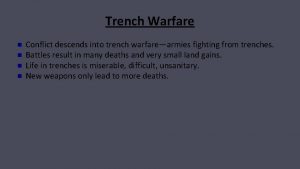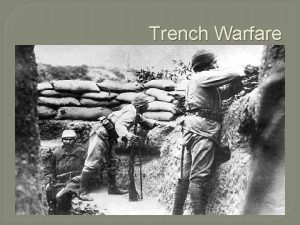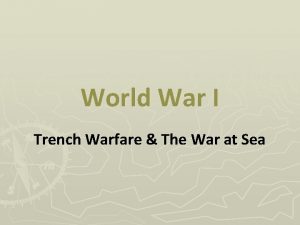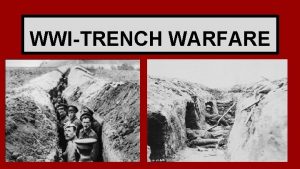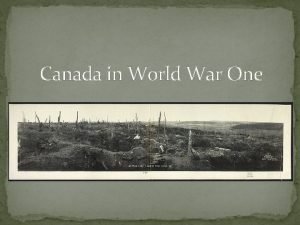Trench Warfare The intensity of World War I














- Slides: 14



Trench Warfare • The intensity of World War I trench warfare meant about 10% of the fighting soldiers were killed. • As in many other wars, World War I's greatest killer was disease. Sanitary conditions in the trenches were quite poor, and common infections included dysentery, typhus, and cholera. Many soldiers suffered from parasites and related infections. Poor hygiene also led to fungal conditions, such as trench mouth and trench foot. Another common killer was exposure, since the temperature within a trench in the winter could easily fall below zero degrees Celsius (32 °F). Burial of the dead was usually a luxury that neither side could easily afford. The bodies would lie in no man's land until the front line moved, by which time the bodies were often unidentifiable.

“No Man’s Land” • Most commonly associated with the First World War the phrase "no man's land" actually dates back until at least the 14 th century. Its meaning was clear to all sides: no man's land represented the area of ground between opposing armies - in this case, between trenches. • During nightfall each side would dispatch parties to spy on the enemy, or to repair or extend barbed wire posts. Reconnaissance missions were similarly common. Injured men trapped in No Man's Land would often be brought in under cover of darkness, as were the dead for burial. Consequently artillery shelling of No Man's Land was common, quickly reducing it to a barren wasteland comprised of destroyed vegetation, mud-soaked craters and rotting corpses.


Layout of Trenches

Trench Foot • Many soldiers fighting in the First World War suffered from trench foot. This was an infection of the feet caused by cold, wet and insanitary conditions. In the trenches men stood for hours on end in waterlogged trenches without being able to remove wet socks or boots. The feet would gradually go numb and the skin would turn red or blue. If untreated, trench foot could turn gangrenous and result in amputation. Trench foot was a particular problem in the early stages of the war. For example, during the winter of 1914 -15 over 20, 000 men in the British Army were treated for trench foot. The only remedy for trench foot was for the soldiers to dry their feet and change their socks several times a day. By the end of 1915 British soldiers in the trenches had to have three pairs of socks with them and were under orders to change their socks at least twice a day. As well as drying their feet, soldiers were told to cover their feet with a grease made from whale-oil. It has been estimated that a battalion at the front would use ten gallons of whale-oil every day.

1917 - World War I in France -these pictures show extreme cases of trench foot.


History of the Gas Masks • Click on this link for more information – • http: //www 33. brinkster. com/iiiii/gasmask/wwi. html When the United States entered the war in April 1917, the U. S. Army was unprepared for chemical warfare and had to use borrowed foreign equipment. Soldiers were issued a British Small Box Respirator (S. B. R. ) for the highest level of protection and a French M 2 Mask for long-term wear comfort. Unfortunately, the untrained troops had a tendency to initially put on the S. B. R. following a gas attack and then switch to the M 2 when it appeared they would have to wear a mask for an extended period of time. Of course, during the mask switching, many soldiers inhaled toxic chemicals and became casualties.




Let’s take a closer look. .
 Trench warfare propaganda
Trench warfare propaganda The war to end all wars
The war to end all wars Trench foot
Trench foot How did the treaty of versailles affect postwar germany?
How did the treaty of versailles affect postwar germany? Why were military leaders baffled by trench warfare?
Why were military leaders baffled by trench warfare? Joint warfare analysis center
Joint warfare analysis center Jewosu
Jewosu Ptsd spiritual warfare
Ptsd spiritual warfare Pros and cons of biological warfare
Pros and cons of biological warfare Selective service act of 1917
Selective service act of 1917 Ephesians weapons of warfare
Ephesians weapons of warfare Spear in spiritual warfare
Spear in spiritual warfare Wage a good warfare with the prophecy
Wage a good warfare with the prophecy Ww1 german allies
Ww1 german allies Undersea warfare conference
Undersea warfare conference




